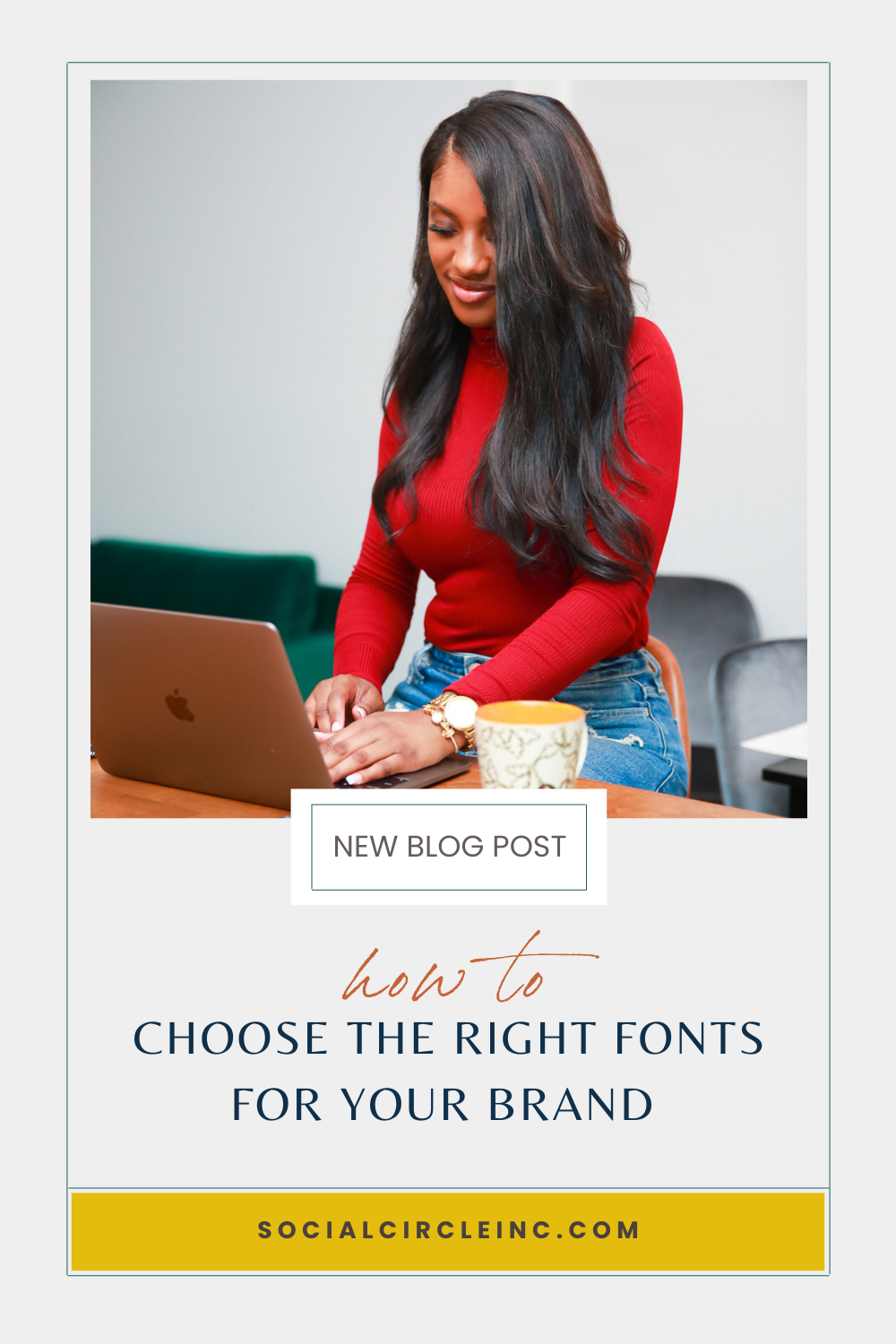When you start building your brand, most of your focus is on your logo design, the colors you’ll use, how you’ll talk to your audience, and what makes your business unique. There’s one underrated brand building block, and that’s brand fonts! Fonts can make your audience feel emotions and they can help people perceive your brand in a certain light.
There’s only so much you can do to control how your audience sees your brand, but you can control all the visuals your audience sees! One of those elements is your fonts. So how can you choose the right brand fonts?
Pick the Right Font That Fits Your Brand Personality
First things first, we want to make sure all aspects of your brand flow together seamlessly. A disconnect between your brand voice and your visuals can cause confusion with your customers, and the same is true if your brand fonts don’t match your logo, color palette, or voice. Choosing fonts that align with your brand identity is crucial. There are mainly four different types of fonts, and they all have different personalities. When paired correctly, they can have a specific effect on the person viewing or reading your content!
Finding the perfect font for your brand can significantly impact how your message is perceived by your target audience.
- Serif fonts – these are the most common fonts around! They’re often seen as classics with a touch of luxury and academia, making it the perfect choice if you want to be seen as a trustworthy expert. Serif fonts are the ones with a small decorative line at the end of each letter. An example of this would be Times New Roman.
- Sans-serif fonts – another one of the most common font choices is a sans-serif font. These are typically used for paragraphs since they’re some of the most legible fonts, making for an easy read when text is small. They’re more modern and masculine, so they tend to evoke feelings of strength and efficiency, which is the perfect choice for online service providers offering done-for-you services! An example font would be Arial.
- Script fonts – also called handwritten fonts, these fonts typically resemble cursive. They’re each unique and have a personality of their own, but are typically seen as more feminine and personal, making it the perfect choice for a women-owned brand that really values authenticity, integrity, and individuality. You can find an example of this kind of font at the end of this blog post where we talk about California Palms.
- Display fonts – these are typically super customized fonts that are only used in small doses. They’re perfect for brands that target a young demographic and are considered quirky and unique. If you want to be seen as a peer or collaborator with your clients, this may be a good font choice! It’s also a good choice if you’re going into a fun niche like canned beverages, clothing accessories, music, photography, or something else that lets your creativity run wild. Comic Sans is a display font, and we all know how it’s torn apart the internet, so don’t forget that these fonts are best used on special occasions!
USE VERSATILE SANS SERIF FONTS
The brand fonts you choose need to look good all over – on social media, your website, your visual brand identity (your logo and its different variations), and any printed marketing materials. Effective font selection should align with your brand’s message and resonate with your target market’s values. So how do you make sure your fonts can be used in all sorts of circumstances?
Free fonts are often open-source and can be a great option for startups and small enterprises with budget constraints. They allow you to achieve a unique visual identity without incurring high costs.
- Use fonts available on various platforms – some fonts you may be able to find on Google Fonts may not be available on Canva where you design social media graphics. While you can upload custom fonts to most websites, it usually costs more and takes extra work. If you’d rather avoid the hassle, make sure you check and see if the fonts you’re thinking of using are available in different places before adding them to your brand style guide.
- Make sure that your fonts have the right balance of professional and personal – using just one font can bore your readers and lack personality, but too many fonts can come across as immature and can limit the trust your audience has for you. By pairing different font types, you’ll achieve the perfect balance of personal and professional. We recommend using a custom serif font for headings and a more common serif font for paragraphs, then a display or decorative font to add a touch of personality occasionally throughout your content!
- One article said it best: “Remember, this is the font you will use everywhere, on virtually every piece of printed material and digital real estate your brand touches. For some companies, these touchpoints can number in the thousands. So, the right brand font will provide the versatility you need to deliver consistent brand expression across every one of those touchpoints.” (monotype.com)
-
Unlock the Branding Strategies of Billion Dollar Brands: Free Brand Strategy Course
Discover the exact process we use to craft breakthrough brands for our clients. Gain valuable insights from our founder, who has extensive experience working with industry giants like Nike, Disney, Hoka, and Coach.
ESTABLISH A FONT SELECTION HIERARCHY
We briefly mentioned adding your fonts to a style guide, but let’s talk more about what that means and why it’s important.
A brand style guide is like a map for visual identities so you always know how to use your branding, where to use it, and everything that’s been created for you by a professional designer. You can also create one for yourself if you’re DIYing your brand!
Inside this style guide, there should be a section for your fonts and your font hierarchy. A font hierarchy is a structure to where and how your fonts will be used. It tells you what fonts to use for headings, what fonts to use for subheadings or subtitles, what fonts to use for paragraphs, and what your accent font is (if you choose to have one). It may also be a good idea to include what size text is best. For some brands, a designer may choose a 32px heading and a 16px paragraph text size, but that may not be best in each brand’s unique circumstances. By trying out different font hierarchies and text sizes before deciding on your final choice, you’ll be confident that your font pairings are perfect for your audience and brand vision!
When designing logos that combine text and icons, it’s crucial to balance different weights to ensure that one element does not overwhelm the other, creating a visually appealing logo.
Creating a visual hierarchy in your font hierarchy is essential. Prioritize the name of the business as the focal point by using contrasting fonts, where a display font captures attention for the main title, and more subtle typefaces are employed for secondary details. This ensures a balanced and effective reading experience.
Font Hierarchy and Brand Style Guides
When creating a brand style guide, it’s essential to consider the hierarchy of typefaces to ensure consistency and clarity in your visual communication. A well-defined font hierarchy helps in distinguishing headings, subheadings, and body text, making your content more readable and engaging.
Aligning your font choices with the preferences and values of your target audience is crucial. Understanding your target audience allows you to select typefaces that resonate with them, enhancing the effectiveness of your brand communication.
Incorporating different styles of typefaces, such as serif, sans serif, and decorative fonts, can convey various brand attributes. Serif fonts often evoke a sense of tradition and reliability, while sans serif fonts are seen as modern and clean. Decorative fonts can add a unique and memorable touch to your brand identity.
Related Post: How to Choose Your Brand Colors
FAQ’s
How to pick the right font for your brand?
When choosing fonts, think about what fits your brand’s style and personality. Consider what message you want to send to your audience and how the font reflects that message. Also, make sure the font is easy to read and works well across different types of media.
How many fonts should I use for my brand?
It’s usually best to stick with 2-3 fonts for your brand. Typically, you’ll want one font for headlines, another for body text, and maybe a third for special elements like calls to action. This helps keep your look consistent while allowing for a bit of variety.
Can I use free fonts for my brand?
Absolutely, free fonts can be a great choice! Just make sure they come from trusted sources and that you have the rights to use them for your brand. While free fonts can save you money, it’s important to ensure they fit your brand and are legally allowed for commercial use.
What are some common mistakes to avoid when choosing fonts for a brand?
Choose fonts that are clear and easy to read, with good spacing between characters. Test how your fonts look on different devices and screen sizes to make sure they’re always legible. If your brand is online, consider using fonts that are designed to be readable on screens.
Do I need to worry about font licensing for my brand?
Yes, font licensing is crucial when using fonts for your brand. Not all fonts are free to use commercially, and using unlicensed fonts can lead to legal issues. Make sure you understand the licensing terms for any font you choose, especially if you’re using it for logos, marketing materials, or on your website. It’s always a good idea to purchase a commercial license or ensure that any free font you use is explicitly labeled for commercial use.

